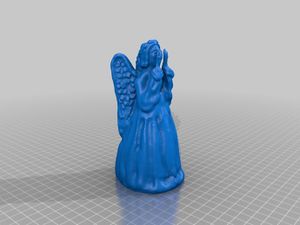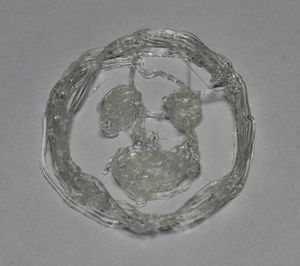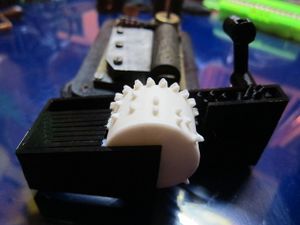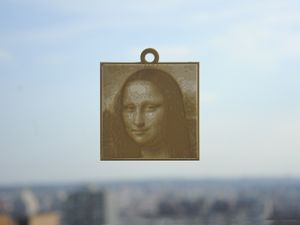User:Tmt5147/Blog
Main | About Me | Class Blog
Contents
Blog 1: Thingiverse
A.Something beautiful
To me, there is nothing more beautiful than a fresh layer of snow on the ground(as long as I have nowhere to be of course). That being said, this 3D printed snowflake tree ornament is something I would put on my tree in a heartbeat. Source
B.Something funny/strange
This is a tree topper in the shape of a weeping angel. I found this funny because as a Doctor Who fan, a weeping angel is not something I would want it my house if it were real so I would never put it on my Christmas tree. Source
C.Something useless
Gestural 3D printing, as it is described sounds pretty much useless. Yes it is cool that you can use a kinect to track your movements and then print out the outline but what use is there? A lumpy smiley face is about all you can do. Source
D.Something useful
Everyone loves music, me included, so this parametric music box would be a cool use. Yes, it wont change the world but it would be a cool thing to give a child. As they grow up, you can print out new snippets of songs for them. Source
E.Something that surprised me
I did not expect to see a customizable lithopane on thingiverse. Never crossed my mind to be honest. In this case, the surprise is good and I already have a few pictures in mind that I would love to turn into these. Source
Blog 2: Open Source Ecology project
Marcin is the man behind the Open Source Ecology project. His idea is to take many machine we use today such as tractors, brick makers and even 3D printers and make open source versions of them that are reparable by the use. His thought behind this is it opens up many to better technology that they will now be able to afford and maintain. Overall, I think this is a good idea and will result in a positive outcome for some people. Open source is a great way to quickly get ideas into the hands of others who will either use them or in some cases even improve upon them. Sadly, I don't know if it will have as big of an impact as he hopes.
Although this is a great idea and already has created many open source designs source, there is only so much open source can do. If someone does not have experience with the tools needed to repair or create these machines, they wont be able to do anything until either they have access to that knowledge or someone close enough to them does the hard part.
The New Yorker magazine wrote an article about Marcin's OSE Project. Summary: Marcin is a 41 year old Polish-American who has spent the past 5 years building industrial machines from scratch. He believes that everyone should be able to have access to the tools needed to work the land. In 2003 he started the O.S.E website to collect the best techniques for creating sustainable communities and three years later he bought a farm in Missouri. He built his own tractor after his old one repeatably broke down. His new tractor cost him $7,000 to build and is roughly equivalent to a $45,000 John Deer. After his success, he posted a list of 50 machines he believes could cheaply provide everything a small community needed to exist. While trying to make 6 tractor in 60 days, his team ran into many problems. Everything from hurt workers to misaligned holes plagued the group. As these projects continue, the common theme is endless struggle. Often called a dictator by those who work with him, conflicts in how things should be done arise. Each video showed the hardship the team faced and after a comment about living conditions was posted, even his girlfriend left. Between the lack of creature comforts and lack of skill, many were frustrated. Article
Overall, this article pointed out many of the things wrong with Marchin's Project. He was very set in his ways to the point of alienating others, didn't give those he worked with any of the money earned from sales of equipment, and didn't do much to improve living conditions. It is not surprising that so many of the people who came to help left. Marchin did respond to the New Yorker magazine article. Source He addressed many of the problems pointed out in the article. Although it doesn't seem like he was just rationalizing things, it may come off to some as such. He did show that he is truly invested in his idea and will do what needs to be done to see it to fruition.
To start something similar at PSU would require people who are truly devoted to the idea. This type of project would require a lot of time, effort, and capital. I personally can not think of specific people for such a job but I would look for people ready to drop what they are doing so they could devote much of their time to the project.
Blog 3: Kansas Teen uses 3D printer to make had for boy
Mason Wilde, a 16 year old Louisbugh High School (Kansas) junior 3D printed a prosthetic hand for a family friend's 9 year old son. The boy was born with only a thumb on his right hand and this prosthetic allows him to grasp things by flexing his wrist. He printed it at the Makerspace at his public library. The parts for this hand can be accessed at here. There is much research going on to look at the viability of 3D printing prosthetic. If you search for news articles on the topic, you will find over 51,000 results. Much good can come from this. Prosthetic are expensive and must be refitted and remade whenever the user grows or changes weight. 3D printing could allow for a cheaper and better fitting prosthetic. Original_Article
Blog 4: Blog 2 Review
As seen above, blog 2 was written about the Open Source Ecology project. For those who don't want to scroll up, the Open Source Ecology project is a project set up by Marcin Jakubowski with the intent of making open source designs for 50 different machines. These range from tractor to brick presses. The idea is to reduce the cost of these machines by allowing them to be created at home. This would allow more people to use them and to make more of the land they have. If you want to see what I think of the idea, please scroll back to blog 2. Reading through what my classmates reactions were, I noticed many similarities. Many thought his project had problems and that the magazine article written about it was on the harsh side. A few students brought up points that did not cross my mind originally that I think are good.
Drew Golterman brought up that Marcin's "One Day Goal" may not be accurate. Just because the designer of a product and assemble it in a day does not mean that everyone can. Unless he takes that into account, many will struggle for days trying to put his designs together. This is not a huge deal but should be thought about to make sure he does not lead anyone astray.
Kyle Casterline also had a good point: Safety. When companies create and market a product, they must meet set safety standards. These open source designs most likely will not include many of those features. They may not have as strong as a roll cage or a gas tank that will not puncture. Although the lack of these standards do bring down prices, they may endanger those who uses these tools if this lack of safety is not disclosed.
The last remark that stuck out to me was by Nate Myer: While discussing Marcin's response to the magazine article, Nate brought up the when Marcin claims that they(the group) are "not letting idealism prevent us from achieving our goals." Kyle called BS saying that deciding not to have electricity until they can make it themselves may be letting his own idealism prevent him from achieving his goals. By creating a nice environment to work an live, the OSE Project could take off and do a lot of good but people don't want to live in filth. Until that changes, I believe Marcin and his project will not go anywhere fast.
Blog 5: RepRap Media Timeline
Looking through all the links on the timeline page, it is easy to see how much has changed in the 3D printing world. Starting with Charles Hull's development of Stereolithography in 1984 all the way to the Hershey Company working with 3D Systems to print candy, this timeline outlines many achievements in 3d printing technology, some more important than others.
One of the most important in my opinion, is the launch of Thingiverse in November of 2008. Although not an advancement of printing technology itself, this was a huge step in bringing 3D printers to the masses. Most people have little to no experience with CAD software. In the past, this was due to the high price of the software itself but even with the advent of google sketch up, most lack the technical skill to design a part let alone one that is functional and printable. Thingiverse changes this but being an online repository of already made models. It doesn't take long to realize just how diverse the selection in. With Thingiverse online, anyone can download a file of something they want and need without needing any engineering skill. One day, it could be just as easy as downloading a news article.




